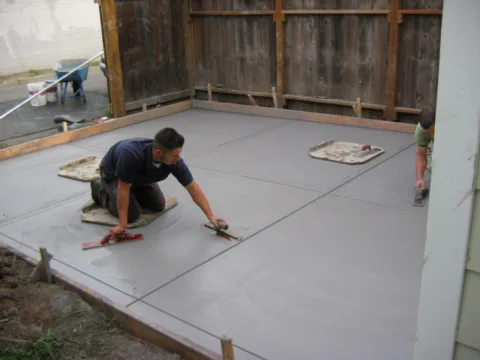When choosing to repair or replace your driveway, cost is often the deciding factor.
Concrete is usually the cheapest way to go for a driveway.
The following tips will help you measure, lay out, and budget for your new concrete driveway — whether you decide to tackle the project yourself or you hire a professional to do the work for you.
#1 – Lay Out The Driveway
Begin planning for your concrete driveway by driving wood stakes into the ground. Follow the edge of the driveway, and pull some string between the stakes.
By laying out the driveway using wood stakes and string, it will be easier for you to visualize the finished driveway. It will also make it easier to get accurate measurements.
How to stake out your driveway:
- Be sure to drive a stake at each end and at any curve or turn in the driveway.
- Make sure the distance between the stakes outlining the width of the driveway is consistent.
- Pull the string to and around each stake to create a rough approximation of the finished driveway.
#2 – Measure Your Driveway’s Length
Use a long measuring tape to measure the entire driveway length.
How to measure the length of your driveway:
- If the driveway curves, keep the tape in the middle of the area that you’ve staked out.
- The average length of a driveway is 38 feet long (without curves or a slope), but yours can be longer or shorter, based on your specific needs.
#3 – Measure Your Driveway’s Width
Next, measure the width of the driveway using the same long measuring tape.
How to measure the width of your driveway:
- If the width of your driveway varies, either take the average width or (for the best accuracy), divide the driveway into sections and calculate each section separately, then add them together.
- A standard 1-car driveway is 12 feet wide. A typical 2-car driveway is 16 feet wide.
Make sure you use reinforcing wire at the base of the concrete.
It may also be helpful to put a layer of plastic for a moisture barrier beneath it to prevent freeze/thaw problems.
#4 – Determine How Much Concrete You Need
Concrete (or any other material used for a driveway) is sold and delivered in cubic yards.
How to determine how much concrete you’ll need:
- Calculate the concrete needed by multiplying the length and width in feet to determine the area. Multiply this number by .35 (4 inches) to determine cubic feet.
- Divide the number of cubic feet by 27 to determine cubic yards.
- If the driveway has a lot of turns or odd angles, separate the areas and calculate each area using triangles and/or circles, then add all the areas together.
- If you expect to drive overweight vehicles on your driveway, then use .5 for the depth to estimate for a 6-inch depth.
- Be sure to add an extra 10% for waste, spillage, and depth variance.
#5 – Calculate The Cost Of Your Concrete Driveway
There are a lot of factors that go into determining the ultimate cost of putting in a concrete driveway:
- size and shape (including curves, slopes, and special features)
- total surface area
- total material volume
- material and surface grade
- equipment and supplies
How to calculate the cost of your driveway:
- HowMuch.net – See How Much A Concrete Driveway Costs
- Fixr.com – See How Much It Costs To Pave A Concrete Driveway
- CostHelper.com – See How Much A Concrete Driveway Costs
- Homewyse.com – See How Much It Costs To Install A Concrete Driveway





